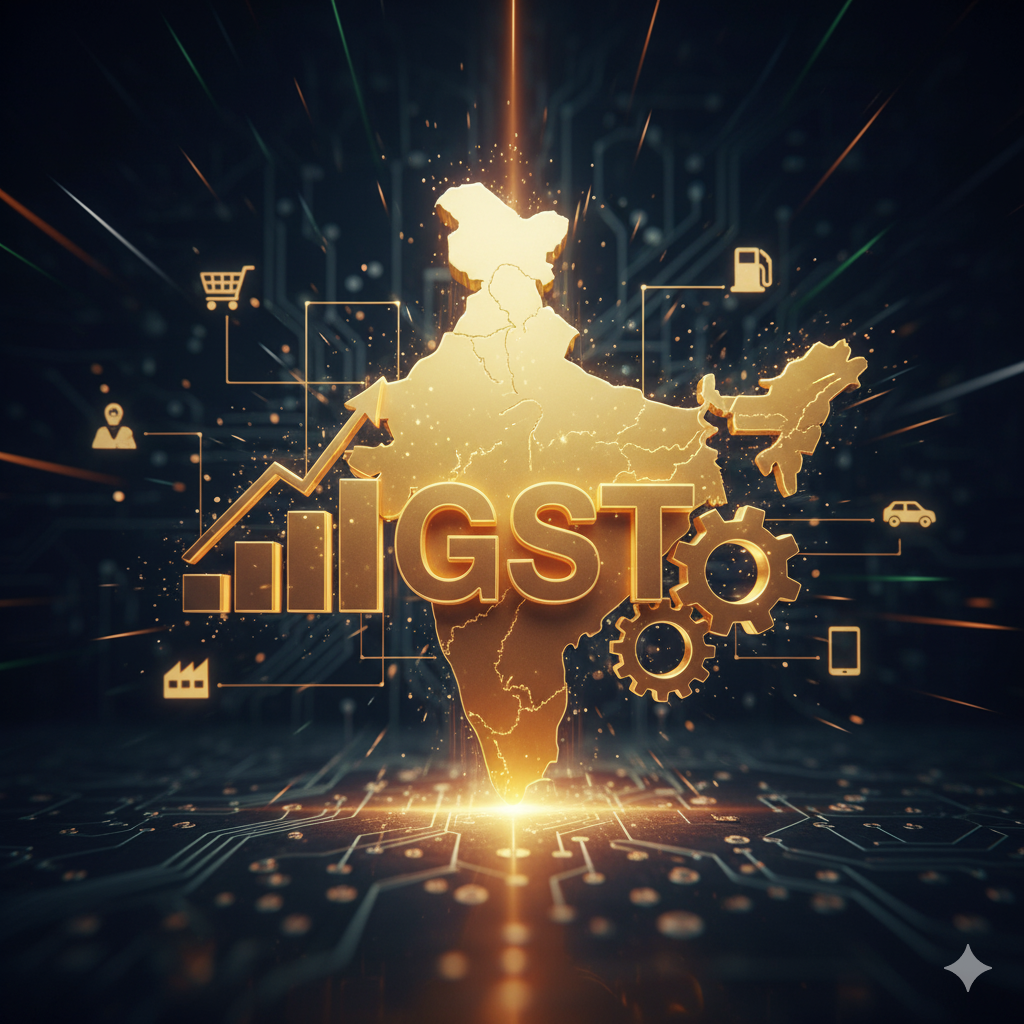Introduction
Taxation has always been a cornerstone of governance, as it provides the necessary revenue for the state to carry out developmental, administrative, and welfare activities. India, being a federal country with a unique distribution of powers between the Union and the States, has a complex taxation structure. Until 2017, India had a web of indirect taxes levied by both the central and state governments. This created inefficiencies, cascading effects of taxation, and compliance difficulties.
To overcome these challenges, the Government of India introduced the Goods and Services Tax (GST), hailed as the most significant tax reform since independence. It replaced multiple indirect taxes with a unified tax system. GST came into force on 1st July 2017, under the constitutional provisions laid down by the 101st Constitutional Amendment Act, 2016.
This article explores GST in detail—its meaning, objectives, features, constitutional provisions, types, advantages, challenges, and its larger implications on the Indian economy.
1. What is Goods and Services Tax (GST)?
Goods and Services Tax is a comprehensive, multistage, destination-based indirect tax levied on the supply of goods and services. It is designed to be a single tax system replacing multiple indirect taxes such as excise duty, service tax, VAT, entry tax, luxury tax, etc.
Key Characteristics of GST
- Destination-based Tax – GST is collected at the place where goods or services are consumed, not where they are produced.
- Comprehensive Coverage – It includes almost all goods and services under its ambit, with a few exceptions like alcohol, petroleum, and electricity (temporarily excluded).
- Dual Structure – Due to India’s federal system, both the Centre and States levy GST in a coordinated manner.
- One Nation, One Tax – GST seeks to unify India into a single market by eliminating state barriers.
- Credit Mechanism – It allows seamless flow of Input Tax Credit (ITC), reducing the cascading effect of taxes.
2. Evolution of GST in India
The idea of GST was not implemented overnight. It went through several stages:
- 2000 – Vajpayee Government formed a committee under Asim Dasgupta (West Bengal Finance Minister) to design a GST model.
- 2006 – Finance Minister P. Chidambaram announced a roadmap for GST in his Budget speech.
- 2009 – First discussion paper released by the Empowered Committee of State Finance Ministers.
- 2014 – Narendra Modi government introduced the 122nd Constitutional Amendment Bill in Parliament.
- 2016 – Parliament passed the 101st Constitutional Amendment Act, 2016, providing constitutional backing to GST.
- 2017 – GST was officially launched on 1st July 2017.
3. Objectives of GST
The introduction of GST aimed to achieve several fiscal and economic goals:
- To create a unified national market by eliminating state-wise barriers.
- To prevent cascading of taxes by allowing seamless input tax credit.
- To make taxation system simpler and reduce compliance burden for businesses.
- To increase transparency in the tax collection process.
- To broaden the tax base and improve revenue collection.
- To make Indian goods more competitive in international markets by reducing production costs.
- To promote cooperative federalism by engaging both Union and State governments in tax collection.
4. Constitutional Provisions of GST
The 101st Constitutional Amendment Act, 2016 inserted several provisions into the Constitution to give GST a strong legal foundation.
Key Provisions
- Article 246A –
- Grants concurrent powers to both Parliament and State legislatures to make laws on GST.
- However, Parliament has exclusive power to make laws on inter-state supply of goods and services (IGST).
- Article 269A –
- Deals with inter-state trade and commerce.
- Provides that GST on supplies in the course of inter-state trade shall be levied and collected by the Government of India.
- The collected revenue is shared between the Centre and States as per the recommendations of the GST Council.
- Article 279A –
- Provides for the creation of a GST Council.
- The GST Council is chaired by the Union Finance Minister, with State Finance Ministers as members.
- It recommends on important matters such as tax rates, exemptions, threshold limits, and dispute resolution.
- Article 366 (12A) –
- Defines “Goods and Services Tax” as any tax on the supply of goods, services, or both, except on the supply of alcoholic liquor for human consumption.
- Defines “Goods and Services Tax” as any tax on the supply of goods, services, or both, except on the supply of alcoholic liquor for human consumption.
- Article 368 –
- Amended to incorporate GST-related provisions into the Constitution.
- Amended to incorporate GST-related provisions into the Constitution.
- Schedule VII –
- Union List and State List were amended to transfer certain subjects to the Concurrent List, allowing both Centre and States to levy GST.
5. Structure of GST in India
India follows a dual GST model due to its federal nature.
Types of GST
- Central GST (CGST) – Levied by the Central Government on intra-state supply.
- State GST (SGST) – Levied by State Governments on intra-state supply.
- Integrated GST (IGST) – Levied by the Central Government on inter-state supply and imports, later shared between Centre and States.
- Union Territory GST (UTGST) – Levied in Union Territories without legislatures.
6. GST Council
The GST Council plays a crucial role in the implementation and smooth functioning of GST.
Composition
- Chairperson – Union Finance Minister
- Members – Union Minister of State for Finance and Finance Ministers of all States/UTs
Functions of GST Council
- Recommend tax rates, exemptions, and threshold limits.
- Suggest model GST laws and procedures.
- Resolve disputes between Centre and States.
- Recommend special provisions for certain States (North-Eastern and hill states).
7. Tax Slabs under GST
GST is levied under a multi-rate structure in India:
- 0% – Essential items like food grains, fresh vegetables, educational services.
- 5% – Essential goods like packaged food, footwear, small hotels.
- 12% – Processed food, computers, medicines.
- 18% – Majority of goods and services including electronics, industrial items.
- 28% – Luxury goods and sin goods (cars, tobacco, aerated drinks).
8. Advantages of GST
- Elimination of cascading effect of taxes.
- Simplified compliance through GSTN (Goods and Services Tax Network).
- Wider tax base ensuring better revenue for both Centre and States.
- Boost to exports due to reduced production costs.
- Encourages formalization of economy by bringing unorganized sectors under tax net.
- Consumer-friendly as it reduces hidden taxes.
9. Challenges of GST
- Multiple tax rates increase complexity.
- Initial IT challenges with GST portal.
- Impact on small businesses due to compliance costs.
- Revenue concerns for some states.
- Exclusion of petroleum, alcohol, and electricity reduces comprehensiveness.
- Frequent rate changes create uncertainty for businesses.
10. Impact of GST on Indian Economy
- Positive Impact – Increased compliance, higher tax revenue, reduction in logistics costs, removal of state border check-posts, strengthening of cooperative federalism.
- Negative Impact – Short-term inflationary pressure, compliance burden on SMEs, transitional issues.
11. GST and Cooperative Federalism
GST is often seen as an example of cooperative federalism in action. Both the Centre and States had to compromise on their exclusive taxing powers for a common goal—creating a unified market. The GST Council ensures equal representation and cooperative decision-making.
12. Way Forward
- Inclusion of petroleum products and electricity under GST.
- Simplification of tax rates into fewer slabs.
- Strengthening GSTN for better compliance.
- Capacity building for small businesses.
- Ensuring stability in GST policies for investor confidence.
Conclusion
The Goods and Services Tax (GST) is undoubtedly a historic reform in India’s taxation system. By subsuming multiple indirect taxes, GST created a transparent, efficient, and unified tax regime. Its constitutional foundation under the 101st Amendment Act ensures legal clarity, while the GST Council embodies cooperative federalism.
Despite challenges in implementation and compliance, GST has already started delivering results in terms of revenue generation, simplification, and market integration. With continuous improvements and stakeholder cooperation, GST can truly achieve the vision of “One Nation, One Tax, One Market.”




